Copyright © Graham Noble 2002. All rights reserved.
Preface
This is the final of four articles about the Indian wrestlers in Europe before World War I. (The first part of this article appears at http://ejmas.com/jalt/jaltart_noble_0502.htm.) Along with my articles on Yukio Tani and Youssuf Ishmaelo, these are chapters from the book I’m trying to put together on turn of the (nineteenth) century jujutsu and professional wrestling. I never intended to write a book, but the interest of the subject took hold, and it somehow seems that the book itself wants to be written. At any rate, when I began to write on these subjects, help and material began to flow my way from some excellent historians and researchers.
I want to acknowledge my use of material from Joseph Alter’s historical essays on Gama, as they were an invaluable source for Gama’s pre-England career. Grateful thanks also go to Robert W. Smith, who first stirred my interest in Gama with his 1963 Black Belt article, who supplied me, just at the right time, with a copy of Muzumdar’s Strong Men Over the Years, and who allowed me to quote extensively from his Stanislaus Zbyszko letters; to wrestling historian Mark Hewitt; to Michael Murphy, who has been amazingly generous in sharing material from his collection; to John Spokes, for the loan of his old editions of Health and Strength; to Joseph Svinth for sending me copies of Ernest Sodergren’s clippings on the Great Gama (which he in turn received from Nadeem S. Haroon); and to the British Library and British Newspaper Library. Thanks are also due to Joe Roark, for obituary material relating to Hackenschmidt and Zbyszko, and Balbir Singh Kanwal, for Indian newspaper accounts relating to Gama and Zbyszko.
Hopefully that’s included everyone, and if anyone has further information
on Gama and the other great Indian wrestlers of the early twentieth century,
please contact the editor at jsvinth@ejmas.com.
VII
Soon after he returned from England Gama fought in a major tournament in Allahabad. (December 1910, though some say 1912.) Here he again met Rahim Sultaniwala, the opponent who had held him to a draw three times previously. Rahim, for some reason, had covered himself in red ochre. This description of the contest is from Muzumdar’s Strong Men over the Years:
Without being announced, without the usual preliminaries the two giants closed in right away. Raheem’s red paint set off Gama’s handsome fairness; in his scarlet trunk-slip Gama looked a veritable Apollo. The very first moment revealed how Raheem respected his opponent, he was on his defence and Gama was at once on the aggressive with his characteristic relentlessness. But times without number the older man escaped his rival’s holds upon him. Apparently deadly holds were broken as soon as they were applied, they were fighting as if to demonstrate text book holds and counters. Raheem fled from the arena twice when Gama forced the pace upon him.
When after the second break-away Raheem returned Gama was determined to make an end of him. If the spectators held their breath in suspense and in unconscious rhyme with the breathless pace of the battle, Raheem did not. He was more and more on the defensive, but coolness and cunning did not leave him. I still remember vividly a particular juncture in this epic fight. Raheem had survived Gama’s repeated onslaughts, but when the latter held him from behind by the trunk-slip the vast appreciating crowd around the arena stood up as one man to witness the grim tragedy of the end of a popular hero. Gama tugged ferociously to bear down his opponent but Raheem stood his ground. At last Gama lifted him bodily up and Raheem hung head downwards in a precarious position. For a moment it seemed that Gama was holding his gigantic rival at arm’s length quite clear of the floor. But Raheem was not rendered helpless; suddenly his legs moved like scissors and with a powerful, incisive movement he struck against Gama’s might arm. The next moment Raheem was standing before Gama in complete defiance. I have taken more time to describe the momentous event than it actually took to happen, for it happened in the twinkling of an eye. Perhaps Gama was exasperated, he rushed at Raheem and clinched, but the latter broke away and wriggled out of the ropes followed by Gama who was now mad with the thrill of the chase. Raheem did not return to complete the fight, he was hurt in the ribs and all the honour of the battle went to Gama, who finally proved the other man’s master.
In 1916 Gama met Pandit Biddo, the top Hindu wrestler (Gama, remember, was Muslim), at Gujranwala. The 17 stone (238-pound) Biddo couldn’t fend off Gama’s constant attacks and was thrown in five minutes. With this victory, Gama reestablished his supremacy over Indian wrestlers, and pretty much seemed to run out of challengers to his crown. He was still a strong presence at wrestling tournaments, and in a major tournament at Kolhapur in 1918, he passed his title of Indian champion to Imam Bux, who had thrown Rahim Sultaniwala in 20 minutes. In 1922, during the Prince of Wales’ visit to India, the future Edward VII presented Gama with a silver mace. One onlooker thought, "seeing Gama with his mace it would appear that the epic hero Bhim had been reincarnated."
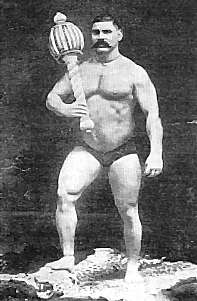
Gama with mace
"From 1916 to 1928," wrote S. Muzumdar, "Gama had no opponents." Then, in 1928, eighteen years after their first contest, came the rematch with Stanislaus Zbyszko.
There was a slightly curious history to this contest. Back in November 1910, Zbyszko said he would be wrestling Gama again in the Punjab the following April. However, 1911 came and went without any return match. After that Zbyszko was wrestling in Europe and North America, and then of course there was the First World War. After that, Zbyszko established himself as a topliner in the States, and it may have only been after he lost the "World Championship" that a rematch with Gama became an attractive proposition.
The February 12, 1927 issue of Health and Strength carried an article, "Two Giants of the Mat." It stated, "One of the greatest events of 1927 in the world of sport" was due to take place soon: the great wrestling contest between Zbyszko and Gama. It said that Gama had arrived in Bombay on December 18, 1926, and had given two displays of wrestling at the Excelsior Theatre. For the match, the Maharajah of Patalia had offered to build "a huge pavilion accommodating about 80,000 persons."
Nothing happened in 1927, either, but in 1928, the Maharajah of Patalia organised a trade fair and, in conjunction with this event, the Gama-Zbyszko rematch finally took place in a specially built stadium accommodating 40,000 spectators. They wrestled on prepared earth, Indian style. Among the crowd were many VIPs, including the Nawab of Bhopal, the Maharaja of Kapurthalai, the Maharana of Dolpur, Sir Leslie Scott (a noted maritime lawyer), and Sir Harcourt Butler (then chairman of the Indian States Committee, and a former governor of Burma). The Maharajah of Patalia, who was sponsoring the match, was in effect Gama’s employer: Gama had been recruited by the Maharajah as a court wrestler around 1910, the time of his last match with Rahim Sultaniwala.
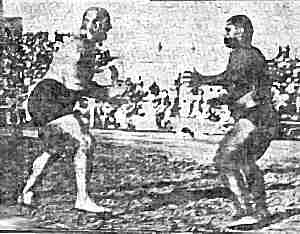
Zybszko and Gama, 1928
Anyway, at 4:15 on the afternoon of January 29, 1928, Gama and Zbyszko faced each other for their eagerly awaited rematch. They came to grips, and then after a few moments Gama released his hold on Zbyszko’s neck and quickly took his left ankle, pulling it forward and simultaneously sweeping away his right leg. Zbyszko went down on his back. Gama followed him down, and after a brief struggle pinned him to the earth for the first and winning fall. The crowd erupted, shouting, "India has won! India has won!" The Nawab of Bhopal presented a silver mace to Gama while Zbyszko retired from the arena "deeply dejected and declaring that Gama was a tiger and a sportsman."
The contemporary reports that I have seen give no time for the fall, although the Tribune stated that "hardly a minute had elapsed" before Gama took Zbyszko down. S. Muzumdar, who was there, gave the time as 42 seconds. Other accounts say 49, 21, or even 10 seconds. And there has been a little uncertainty about the nature of the fall: that Zbyszko may have been thrown "just off his feet," for example. However, the Indian accounts are fairly clear in saying that Zbyszko was pinned, and in fact the 1928 reports from The Tribune (January 31, 1928) and Vyayam magazine, both state that Zbyszko was "completely overpowered" on the ground.
"Completely overpowered" – I wonder. It’s no surprise that Gama took Zbyszko down quickly, since he demonstrated he was able to do that repeatedly in their first match, but to "overpower" him on the ground? How was the 48-year-old Gama of 1928 able to pin Zbyszko in less than a minute when the Gama of 1910 was never able to get close to a pin in over two and a half hours of wrestling? No doubt Zbyszko was unused to the conditions, and he later said that the fall was called too quickly. Perhaps in the eighteen years since the first contest Zbyszko had got weaker and Gama had somehow grown stronger. However, I can’t help having doubts about such a quick and easy win.
In some correspondence, wrestling enthusiast Ernest Sodergren wrote, "In the second match with Zbyszko, in India under Gama’s conditions and style, there was a lot of suggestion that there were suspicious circumstances about the match. This was conveyed to me on a number of occasions by wrestlers coming home from India in the fifties but none of them were too happy to elaborate other than to say that rumour was rife over there about the outcome." Richard Haynes, in his wrestling record book, also wrote that the "Maharajah had come to Zbyszko to offer the Pole $50,000 ‘to let Gama throw you.’ The Maharajah had feared that if Zbyszko had won there would have been a riot and was afraid for his own safety as well as Zbyszko’s. Zbyszko was rebuilding his own fortune lost in World War I, and gladly accepted the offer. It must be stated that Gama knew nothing of this. If he did, he most certainly would not have gone on with the match. So, before the largest crowd ever to see a wrestling match, Gama won in less than one minute."
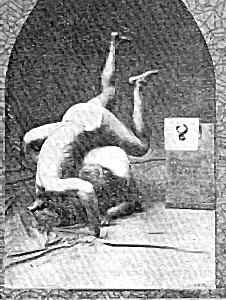
Indian wrestlers demonstrating flying mare
Well, it’s all rumour and hearsay, but there may be something in it. None of the reports, of course, mentioned any payoff by the Maharajah, but Zbyszko had all his expenses reimbursed and reportedly received $8,000 win, lose, or draw, so really, there was no incentive for him to try too hard. Zbyszko was a veteran professional and it doesn’t seem too farfetched to suggest that he would roll over for a good payday, especially as his competitive days were then drawing to an end. Certainly, it is strange that Zbyszko, who must have been one of the most difficult men in the world to pin, lost two of the quickest pin-falls on record: 6 seconds to Gotch and 42 seconds (or whatever) to Gama. True, Gama may not have known about any arrangement, but he was a very, very experienced wrestler and if Zbyszko had succumbed too easily, then surely Gama would have sensed it. While this quick win is now recognised as one of the highlights of Gama’s career, S. Muzumdar, who was a real Gama fan, once mentioned that "at the time of this fight most Indian newspapers criticised it as a battle between two old, dilapidated, slow moving persons."
A year later, in February 1929, Gama wrestled Jesse Petersen, another name from the old days. Although not much remembered today, Petersen was one of the leading Greco-Roman wrestlers in Europe in the early 1900s. He was often among the top finishers in the major European tournaments and won the big world tournaments held in Paris in 1908 and 1910. Now it was two decades on, and as Petersen took off his dressing gown at 4 o’clock in the afternoon of February 24th, "acute judges could see that his muscles were not in first class condition and there were folds beneath his chin; and his arms and chest looked flabby, while his thighs and calves were too poor for a first class wrestler."
The following account is from The Tribune of Lahore:
Gama at once went for his rival’s legs but his hands slipped off them. The two stood crouching again, eyeing each other, but Petersen’s glance was uneasy. He looked like a man expecting an attack from an unexpected quarter. Gama caught Petersen by the legs again and as he had sanded his hands this time the grip held. In a flash Petersen came down like a log on his right shoulder and part of his back. Gama was down on his rival pressing with his full weight and strength on Petersen’s left shoulder.
I could not see it, though I was quite close; but I was told that Petersen’s left leg got flexed, so that his left foot came under his right leg after the fall. This made it still more difficult for him to get up. Relentlessly Gama exerted himself and I could hear Petersen gasp with pain and exertion. Knowing that he might be thrown down on one shoulder, Petersen had specially trained to keep the other shoulder up. It was relying on this training that he had got a condition inserted in the terms of the match that both shoulders must touch the earth simultaneously. But all his special training, or his strength, availed him not. The pain and the weight of the other proved too much. Slowly, after a brave but unavailing struggle of some seconds, his other shoulder touched the earth and he raised his hand in token of defeat. Gama jumped off and the match for the world championship was over in a minute and a half.
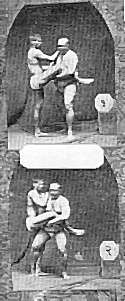
Indian wrestlers demonstrating single leg throw
Gama didn’t retire; he just stopped wrestling competitively. Yet he still considered himself world champion, and as late as 1937, Muzumdar could write, "without any shadow of doubt he is the greatest wrestler of the present time. He believes that he won the world title twenty seven years ago by defeating Stanislaus Zbyszko in London. He is advanced in age now, but if I am any judge of his physical condition I can candidly say that none of the young super-wrestlers of India would be able to extend Gama for ten minutes."
How strong a wrestler was Gama? Very strong, I would imagine, and very quick. However, in trying to answer this question you have to try to clear all the inaccurate information that has accumulated over the years. The legend of Gama seems to have a life all of its own. In an error-filled article of 1947 by Charles B. Roth (Your Physique, December 1947), the "sixty-nine year old" Gama was described as the toughest man in the world, and the "unofficial heavyweight wrestling champion of the world." Roth stated that in England, "at a private get together," Gama threw Doc Roller thirteen times in fifteen minutes. Another biographer, Ratan Patodi, wrote that, also in England, Gama threw thirty Japanese wrestlers in one hour. And on a recent website, it’s asserted that before meeting Zbyszko, Gama defeated 200 wrestlers in the preliminary rounds of the John Bull Tournament.
Well, Doc Roller was thrown (pinned) twice in ten minutes of wrestling, and there is no mention of Gama throwing thirty Japanese, although he did make that challenge. There was no John Bull tournament, and the two hundred wins in the preliminary rounds are simply a fantasy. There may be some bizarre confusion here with newspaper reports stating that Gama was undefeated in two hundred contests in his native India.
Gama seems to have been recognised as a prodigy from an early age, and as victory followed victory over high profile opponents, he came to be recognised as a great wrestler, a modern day "incarnation of Bhim." In Strong Men over the Years (1942), Muzumdar wrote:
I believe that Gama and the wrestlers of his school are unbeatable because their methods have been different to older ones. All of them seem to be imbued with the idea that aggressiveness is the best defence so they start their fights in such a pace as to completely overwhelm their adversaries and force an issue as soon as possible. Just as boxing in England and elsewhere used to be long drawn out ‘marathon’ affairs a few decades ago, wrestling battles lasting for hours used to be almost a feature in India. ‘Marathon’ wrestling has now become an exception [rather] than the rule, but be it said that Indian wrestlers of all schools invariably train themselves to last out indefinitely if such demands upon their stamina rise. This sort of a power is now a personal asset of the wrestler; the needs of the day expect him to finish quickly or be finished so.
In 1916 Gama met Pandit Biddo, the greatest Hindu wrestler after Kikkar Singh. Biddo was a much older man and represented the older form of the grappling art I have just mentioned. This match took place in Gujranwala, Biddo’s home town, and Gama forced the issue in eight minutes. Biddo did not get a single chance to strike out. With the defeat of Biddo Gama wiped out the last of his Indian opponents, and since then he has been regarded as the living ideal [rather] than a profane competitor by all the Indian wrestlers.
But that report also mentioned that Gama did little training in groundwork, and others mentioned a possible weakness in this part of wrestling. Gama came to England the great Indian champion, and although the Indians quickly proved themselves terrific straight wrestlers, the first Zbyszko match tarnished Gama’s reputation. Eighteen years later he redeemed himself in the sensational Patalia rematch, which then became a central part of the Gama legend. Gama had to wipe out the memory of the first match, and achieved that in a manner better than anyone could have hoped. Nonetheless, the first, Shepherd’s Bush Stadium, contest had highlighted chinks in Gama’s wrestling ability.
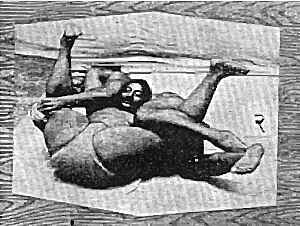
Indian wrestlers demonstrating leg tear
In England, Gama would regularly work out with the other Indians in the troupe, and in training and exhibition bouts in the music halls, he was absolutely acknowledged as the strongest wrestler. Yet when it came to actual performances against western opponents, Gama’s performances in England were somewhat eclipsed by the victories of Imam Bux and Ahmed Bux. After the Zbyszko match, Henry Werner had written that letter saying that Imam Bux would have been a better opponent for Zbyszko than Gama, and in fact that was not a rare viewpoint. The editor of Health and Strength wrote that, "in my opinion, he [Gama] is not quite so clever a wrestler as his brother, Imam Bux, who enjoys the advantage of a longer reach." Another expert (not named) considered that both Imam Bux and Ahmed Bux were superior ground wrestlers to Gama, though perhaps not as strong.
Doc Roller, apparently, told Joe Carroll Marsh, Frank Gotch’s one-time manager, that Gotch was a superior wrestler to Gama, and Zbyszko, after the Shepherd’s Bush Stadium match, told Tromp Van Diggellen that Gotch would beat Gama in ten minutes. Around the same time, however, Zbyszko told R.B. Benjamin that he would back Gama for £500 against anyone in the world in standing wrestling.
So it was in ground wrestling where Gama was judged wanting, at least in Western terms. That may have been due to the style, rules, and techniques of Indian wrestling, and it’s interesting that Gama’s problems with Zbyszko seem to have been almost a rerun of the great Gulam’s match with Cour-Derelli ten years earlier, although Gulam never received the criticism that Gama did. Strangely, wrestling Western opponents on the ground didn’t seem to bother Imam Bux or Ahmed Bux.
Imam Bux, though, was a younger brother, so he was always in Gama’s shadow, and he was beaten by Gunga, the deaf-mute, while Gama was never thrown in his whole career. Gama was the king of Indian wrestling: his greatest victories were in the earth pits of India. [EN1] It must have been terrific to watch him in one of his famous quick wins, with his fast, fluid, continuously attacking style bringing him victory in a matter of minutes. He seemed perfectly fitted for his role of the dignified, modest, and straightforward Indian super-wrestler, the victor in hundreds of battles, conqueror of Western champions, and the embodiment of Indian masculine virtues.
S. Muzumdar, in his Strong Men over the Years, wrote that a "fighter like Gama is expected to be the hero of hundreds of battles, but curiously enough he had not had much fighting to do in his whole career." The British press in 1910 reported that Gama was undefeated in 200 bouts in India, that he had never been pinned, and no opponent had ever been able to get behind him. After he returned from England, Gama had a major win over Raheem Sultaniwala, and six years later he defeated Pandit Biddu, but after that, having established himself as the Champion, he seemed to rest on his laurels. In 1918 he passed the Championship of India over to Imam Bux, and then a decade later the victories over Zbyszko and Petersen closed off his competitive career.
He still seemed to keep up his disciplined regime of training, still doing his thousands of dunds and baitheks every day, and wrestling numerous opponents at his gym. Muzumdar recalled one occasion at Allahabad in 1934 when the 54-year-old Gama gave him a private exhibition of wrestling with his own men.
In 1929 a Sydney group, Stadiums Ltd., tried bringing Gama to Australia, and in 1935 Jack Curley announced that he would be bringing Gama over for a tour of the United States, but nothing came of these efforts, and so Gama remained in India, teaching and training. He was sometimes urged to retire but refused, and so while his competitive career faded away, his continued presence (and reluctance to face new challengers) must have had a rather stultifying effect on the sport. Writing in 1941, Bill Hillgardner reported that, as "Gama is still considered champion of the largest camp, and no one can defeat him, the others can only compete unofficially, without any title at stake. This, of course, keeps the wrestling game at more or less of a standstill here in India, especially as concerns a new champion being crowned." Gama did eventually relinquish his title, date uncertain, but sometime in the early 1940s.
If Gama had considered an Australian tour in 1929 or American tour in 1935, it’s hard to see how it would have worked, especially if he was expecting to wrestle real matches. Professional wrestling by this time was wholly worked, and Gama was such a proud man that it’s difficult to imagine him agreeing to lose a match, or even a fall. Imam Bux, however, did wrestle in Canada during the mid-1930s, and others appeared in Western rings with mixed success. The sensational victories of the early 1900s no longer seemed possible. In a 1928 article on Indian wrestling, Robert L. Jones attempted to answer the question, "Just how good are these Indian wrestlers, and how much do they know of the art?" His response was: "I cannot answer that question, nor do I know anyone who can answer it at all fully." He did refer to Gama and Imam Bux’s victories in London, but also mentioned Pandit Biddu’s defeat by Zbyszko in America (1920s, I guess), and Gobar’s losses to some "unknown" German and to Ed "Strangler" Lewis. He also pointed out that Indian amateur wrestlers had made little headway in the Olympics. Likewise, strength historian David Willoughby referred to a troupe of Indian wrestlers who toured America in the 1930s. Several of them, he wrote, "engaged in shooting matches with ordinary (not champion) American wrestlers and were held to draws, or even defeated." Willoughby also mentioned a letter he had from an Indian wrestling enthusiast, who gave his opinion that the "Hindu [e.g., Indian] system of training produces only obese, sluggish individuals, good only for wrestling, overeating and sleeping."
As for Gama, judging from assorted old clippings, his later years were troubled. He had five sons and four daughters, but all the sons died young. In 1945, Jalaluddin, his last son, died aged just thirteen, and Gama was so heartbroken that for awhile he lost the power of speech. In 1947, like millions of others, he was caught up in the bloody partition of India and Pakistan, losing most of the wealth and property that he had accumulated in his long wrestling career. Over the next few years he had to sell six of his seven silver victory maces. In 1951, apparently, he wrote to his old opponent Stanislaus Zbyszko about the possibility of staging international wrestling matches. Nothing came of that, but in the same year, in Karachi he took out a loan from the Refugee Rehabilitation finance corporation to buy a bus and set up the "Gama Transport Service." The company struggled for a couple years before he gave it up and returned to Lahore. A wrestling exhibition tour of Kenya and Uganda with Imam Bux in 1953 was financially unrewarding and had to be cut short when the 73-year-old Gama took ill and began spitting blood.
In 1955 he issued a final, sad challenge to an indifferent world, saying that he would wrestle anyone, anywhere, at any time. In the same year the government of Punjab gave him some land to support himself, his wife, and their two unmarried daughters, and he had the first of his heart attacks. Three more followed, and the cost of treatment for his heart, high blood pressure, and asthma reduced him almost to penury.
An industrialist, C.D. Birla, heard about Gama’s plight and gave him a grant of 2,000 rupees and a pension of 300 rupees a month for a year. Others rallied round. The West Pakistan Health Minister had Gama admitted to the Mayo Hospital at public expense, and other government departments and supporters helped. You like to think that after all his troubles, the old champion had some small measure of rest and comfort in his last few years.
Longtime wrestling fan Walter Steinhilber wrote about his 1960 trip to India and Pakistan, and his meeting with Gama in Strength and Health, March 1961. The old wrestler was then a patient at the Mayo Hospital in Lahore. "The Chief Physician," wrote Steinhilber:
In his hospital wardrobe and a woollen scarf wrapped as a turban, there was little to remind one that here, as a fact, was one of the giants of all time… The Indian wrestler who had dispatched the great Zbyszko in a matter of minutes… whose majestic pose, carrying the mace of mastery, left one awestruck.
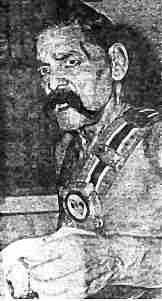
Gama, ca. 1960
The visit was quite a formal occasion, since Steinhilber was accompanied by a military attaché and other VIPs. Photos were taken and then the attaché presented the old champion with baskets of fruit and flowers and a cheque for 1,200 rupees, worth about $400 then, apparently. As he took the gifts, Gama’s eyes were filled with tears.
When he returned home, Walter Steinhilber wrote to Pakistan for copies
of the photos. The copies arrived with a note from the Director of Public
Relations. It simply read: "Gama died 5/22/60. With the passing of this
man ends an epic."
VIII
After the Shepherd’s Bush Stadium debacle, Stanley Zbyszko wrestled throughout Europe and America. He seemed to spend most of 1911 in the USA and Canada. In February he lost a match with Maurice Deriaz (the same Maurice Deriaz he had beaten a year earlier when he was being built up as the leading challenger to Gotch), and then on February 9, 1911, a match with George Hackenschmidt finally came about in Madison Square Garden before a crowd of 8,000 or so. Hackenschmidt undertook to throw (pin) Zbyszko twice in an hour, and although he was described as the cleverer and stronger wrestler, he was unable to do that (or throw Zbyszko even once). Therefore, although it was actually a draw, by the terms of the contest Zbyszko had won. I assume it was a work: an American paper reported that "when the match was made a prominent sporting man expressed a willingness to bet 1,000 dollars there would be no fall, but he couldn’t find a taker."
Zbyszko continued to wrestle, and in 1914, by his own account, he was in Russia when the First World War broke out. He remained there, continuing to wrestle until the start of the Russian Revolution. He often told the story of how he had been accused of being an Austrian spy and ordered to wrestle the well-known Alexander Aberg in front of a murderous crowd of armed Bolsheviks who threatened to execute him if he lost – and of how he beat Aberg after two hours of wrestling, threw the winner’s purse of gold coins into the crowd, and made his getaway as the soldiers scrambled for the money.
Zbyszko returned to America in 1920. If his name was remembered, it was as someone from that distant, pre-war world of pro wrestling. He began wrestling across the country, several matches every week, to try to reestablish his presence on the American scene. Before long he was a contender, and in 1921 he beat Ed "Strangler" Lewis to become World champion. He lost the title back to Lewis the next year, but continued to wrestle at the top level for the next three years. Consequently, when Lewis "lost" the title to Wayne Munn, a big ex-football player with limited real wrestling ability but a good box office draw, Zbyszko was there as an opponent for Munn.
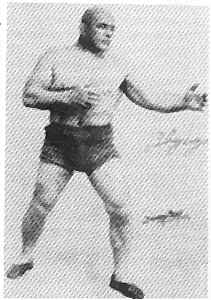
Stanislaus Zbyszko, 1920s
The first time the two men met, Zbyszko lost, but then a couple of months later, April 15, 1925, in Philadelphia, they met again. The inside story of this match, at least according to Marcus Griffin’s Fall Guys, is that Zbyszko agreed beforehand to lose, but then took Munn down repeatedly and pinned him twice – in eight minutes and then four minutes – to regain the World Championship. "The Zbyszko victory over Munn," wrote Griffin, "was one of the epochal doublecrossings of matdom."
Zbyszko’s second reign, however, didn’t last any time at all: just a few weeks later he lost the title to Joe Stecher in St. Louis and that marked the beginning of the end for his long run at the top. In 1928, he went to India for the second Gama match, and although he continued to wrestle for several years after that, he was now out of the championship picture. According to Nat Fleischer in From Milo to Londos, Zbyszko retired from active wrestling in 1935, and subsequently took up promoting in Argentina. Antonio Rocca was reportedly one of his discoveries there.
After that, I don’t really know, but Zbyszko seemed to remain involved in the game as a manager and trainer. He appeared in the ring one more time, in Night and the City, Jules Dassin’s 1950 film noir set in a seedy subculture of pro wrestling in postwar London. In this Richard Widmark vehicle, Zbyszko played the role of Gregorius, a legendary grappler from the old days and the last remnant of true wrestling in a corrupt and degraded modern world. Towards the end of the movie, during an evening training session, Gregorius begins to argue with the modern day champion, The Strangler, played by Mike Mazurki. This escalates into a real fight, and as they lock into holds, an onlooker says, "The only way to stop them now is to shoot them like mad dogs!"
Since both Zbyszko and Mazurki were veteran wrestlers, they were able to produce one of the best fight scenes in movie history. It’s put together as a contrast in styles, with Gregorius opposing his old style pure wrestling against The Strangler’s modern, brutish, all-in methods. As the advantage swings from one to the other, there are no flashy techniques, just basic moves and a real sense of physical struggle. Both men seem to put forth the utmost effort and determination in a desperate battle to gain the upper hand. Interestingly, the action seems to anticipate the no-holds-barred fighting of the 1990s, and that makes it almost unique in the history of movie fight scenes.
Anyway, old Gregorius is strangled, hit by punches, forearm smashes, chops, and elbows, but he keeps wrestling, and gradually he gains the advantage. When he is able to get The Strangler in a "bear hug," he squeezes all the breath out of him and then lets him fall unconscious to the mat. As he exits the ring, he sees The Strangler’s promoter (who ironically in his very own son), and tells him: "That – is what I do to your clowns."
He walks back unsteadily to the changing rooms. He lies down to recover his strength, and after saying a few words – "My son, Graeco-Roman, great art… great beauty. Must fight to keep… I have good life." – he dies in his son’s arms. It’s kind of corny, and yet even after watching the film several times, I still find these scenes oddly touching. Zbyszko wasn’t an actor, but his gnarled charisma and broken English made him a perfect choice for the noble, enigmatic, and completely fictitious Gregorius.
There was an unusual sequel to this, which was played out, not in the ring, but in the English law courts, the King’s Bench Division, before Mr. Justice Pritchard. It was October 1950, and the 72-year-old George Hackenschmidt was suing News Review for defamation. In June 1949, apparently, Hackenschmidt also had been approached by 20th Century Fox regarding the role of Gregorius. He had bought wrestling kit, learned the lines, and then, of course, the role went to Zbyszko. That would have been annoying in itself, but Hackenschmidt then read an article in News Review that implied that he had been beaten by Zbyszko in a wrestling match forty years before. The article included the lines, "When Stanislaus Zbysco, the world champion wrestler, topped the London Pavilion forty years ago, one of his most formidable victims was Hackenschmidt. Last July, seventy year old Zbysco again beat Hackenschmidt and fifteen other aspirants for the role of Gregorius, the Greco-Roman wrestler, in Night and the City."
Hackenschmidt, his counsel explained, was a writer on philosophy who had lectured at various universities, including Yale. He had written several books, and was now working on his autobiography. His 1911 Madison Square Garden match with Zbyszko was referred to, being correctly described as a draw, although Hack failed in his stated objective of throwing Zbyszko twice in an hour. But Hack had never been "a victim" of Zbyszko.
Judgment was given in Hackenschmidt’s favour, and News Review was ordered to pay him £300 in damages, which was a fair amount of money in those austere postwar years. (An equivalent award today would be in the neighborhood of £5,800.) News Review had probably picked up something Zbyszko had said, without checking the facts. Zbyszko seemed to regard that 1911 draw as some kind of technical victory, and in a 1927 Health and Strength article a short list of his notable victories again included George Hackenschmidt’s name. But I don’t suppose Hack ever saw that issue.
In his later years, Stanislaus Zbyszko retired to Savannah, Missouri, from where, like a real life Gregorius, he railed against the degeneracy of modern professional wrestling. In July 1953, for example, he told Arthur Daley of the New York Times that modern pro wrestlers were "carnival clowns." He could not understand why "the public not only seem to like it but pays for this disgrace, this insult to common sense. If the public would refuse to be cheated, the promoters would be compelled to turn to useful work. Maybe then these stupid ‘rasslers’ would stop their disgraceful stupid shenanigans which were drilled into them before each and every show."
In 1957, Robert W. Smith, researching wrestling history, wrote to Stanislaus Zbyszko, and he replied at length, albeit in a letter full of typing errors and broken English. ("Hope only you will survive the torture of reading my typewriting – but that’s the best I could do.") Zbyszko wrote about his life, and also commented on some of the characters he had met in his decades-long wrestling career.
"The Pearl Harbor day for wrestling," he wrote:
… [Jack] Curley and Co. seeing the money Bowser was making they selected Jim Londos to make him ‘WORLDS CHAMPION.’ He looked more muscular than Sonnenberg, was better as wrestler goes, than Sonnenberg. He was afflicted with yellow streak, Londos simply could not wrestle on the level. I imagine it would be easier for him to [face the] electric chair than genuine opponent. Still in gymnasium he was pretty clever small man. Then the other Promoters seeing how State Athletic Commissions were willing and ready to cooperate in faking of wrestling and jibbing the public of money. Then they started to make their own champions, every hall subsequently had its Worlds Champion.
Worlds Champion nickel a bushel. That’s the downfall of this noble sport of wrestling, just to be like rotten apple a rotten apple for rest of the sports.
Zbyszko added some new information on this 1910 contest, writing that Gama "issued challenge to everybody including Hackenschmidt to throw him twice in twenty minutes."
"In 1926 [sic]," Zbyszko continued:
Pfeffer’s puzzlement was understandable since Zbyszko was one of the biggest earners in pro wrestling in the early 1900s. Even if, as the stories say, his wealth was wiped out in the First World War, he was able to start a new career in 1920s America and win the World Championship twice. A Health and Strength article of 1927 stated that he "owns farms in America and estates in Russia, has real estate in New York and owns a large summer hotel at Old Orchard, Maine." Maybe his later years were lean, or he lost money in managing and promoting, or his accumulated wealth was just gradually used up in the course of his long life.
One by one they had all passed from the scene. Frank Gotch was the first to go, in 1917. Only 39, he had been in poor health for months, and died of uremic poisoning (or, some say, of syphilis). Little attention was paid to the death of Gotch’s one-time mentor, Farmer Burns, in 1937. "He was a very remarkable old fellow," Jack Curley wrote in a memoir of Burns published in The Sporting Arena in March 1937.
There were a lot of people who never knew him except as a gabby old guy on that street corner, but I knew him when he was a real good wrestler.
Tom Jenkins, who once had that see-saw rivalry with Gotch, and who had
pretty much wrestled them all, from Youssuf the Terrible Turk to George
Hackenschmidt, died in 1957, at the age of 85. Gama, of course, died in
1960, and now Zbyszko too was gone. Only the old Russian Lion remained.
The 90-year old George Hackenschmidt was living quietly in London with
his wife, and when he too passed away on February 19, 1968, the curtain
finally came down on professional wrestling’s turn-of-the-century Golden
Age.
ENDNOTES
EN1. According to D.C. Mujumdar, writing in Encyclopedia
of Indian Physical Culture (Baroda, 1950), the dimensions of a pit
varied from 14-20 feet square. "Earth therein is scientifically prepared
by the mixture of earth and ochre. The mixture is made soft by adding sufficient
quantity of sesamum [sesame] oil. In order to make it more soft[, a] good
deal of butter milk is added to it. Besides, camphor, lemon-juice, rose-water,
rose-essence and other articles of scent are mixed with this special earth."